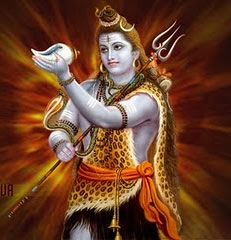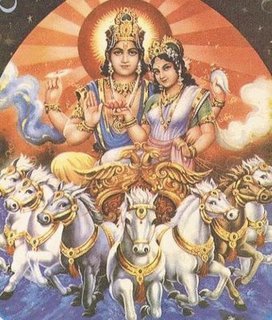From the Brahma Vaivarta Purana
The following are ten verses from the Brahma-vaivarta Purana that were spoken by Lord Krishna to Mother anga just before the beginning of Kali yuga (the age of quarrel and strife). Kali yuga began approximately five thousand years ago, and it has a duration of 432,000 years, leaving us with 427,000 till the end of the present age. [For a description of Kali yuga, please read the related article "Predictions for the age of Kali".] Within his 432,000 year period, there is a period of 10,000 years that will be a golden age. That golden age is being described below by Lord Sri Krishna. This text is taken from the Brahma-vaivarta Purana.
Text 49
bhagarathy uvaca
he natha ramanashreshtha
yasi golokamuttamam
asmakam ka gatishcatra
bhavishyati kalau yuge
Translation
Ganges said: O protector, Supreme enjoyer, on your departure for the perfect
abode, Goloka, thereafter what will be my situation in the age of kali?
Text 50
sri-bhagavan uvaca
kaleh pancasahasrani
varshani tishtha bhutale
papani papino yani
tubhyam dasyanti snanatah
Translation
The blessed Lord said: On the earth 5,000 years of kali will be sinful and
sinners will deposit their sins in you by bathing.
Comments:
We have presently passed through just over 5,000 years of Kali yuga. As was predicted by Lord Krishna, his period from the end of the previous age to the present comprising 5,000 years was a period of great degradation and darkness. The great and ancient Vedic culture of India was lost and the so-called followers became ritualistic practitioners, interested only in the bodily conception of life. The four pillars of spiritual life, namely truthfulness, austerity, cleanliness, and mercy are practically nonexistent today, even in the so-called holy sites of pilgrimage. The general mass of people have no interest in God, and any remnant of religion they might still follow is simply for the purpose of economic development. In the name of God so many sinful acts are being carried out throughout the world. Killing of innocent animals, intoxication, illicit sex, and gambling have become common and "natural" activities supported by the governments and religions of the world. All of these points confirm Lord Krishna's prediction regarding the first 5,000 years of the Kali yuga.
Text 51
man-mantropasakasparshad
bhasmibhutani tatkshanat
bhavishyanti darsanacca
snanadeva hi jahnavi
Translation
Thereafter by the sight and touch of those who worship me by my mantra, all those sins will be burnt.
Comments:
Lord Krishna has said that for 5,000 years mother Ganga will purify the sinful inhabitants of the earthly planet in the age of Kali. But where will those accumulated sinful reactions go? Therefore Krishna says here that those sinful reactions, accumulated for thousands of years will all be burnt to ashes simply by a moments touch of a pure devotee of the Lord. The word tatksanat indicates that immediately the reactions are destroyed. A moments glimpse of a pure devotee is enough to purify the heart of a sinful man in this age of Kali. Even
mother Ganga is blessed and purified by the association of the Lords devotees, so what to speak of fallen souls like ourselves. We must take every opportunity to associate with the Lord's pure devotees. This is the process of sadhu-sanga,or sat-sanga. Through association with the saints, we come in contact directly with the Supreme Lord. If we have such a great fortune to associate with the saintly devotees of the Lord, our heart will be purified of all the sinful reactions accumulated from countless lifetimes. In this verse Krishna defines who are those pure devotees: man-mantropasaka,"one who is doing upasana, or worship, of Krishna by chanting Krishna's mantra." It should be noted that Krishna does not say mother Ganga will be purified by
yogis. Nor does he say she will be purified by jnanis. Nor by rishis, tapasvis, siddhas or a host of other saintly minded men. Krishna says it will be His pure devotees (bhaktas) who chant mantra that will purify
mother Ganga and the entire age of Kali. Only the chanting of Krishna's holy name is powerful enough to purify this present age of Kali. Therefore only the Lord's devotees have the power to bring about the golden age within Kali yuga.
Text 52
harernamani yatraiva
puranani bhavanti hi
tatra gatva savadhanam
abhih sarddham ca shroshyasi
Translation
There will be chanting of the name of Hari and reading of the [Bhagavata] Purana. Reaching such a place, attentively hear.
Comments:
Here Lord Krishna describes the activities within the golden age that will purify the Kali yuga. First and foremost is the chanting of Lord Krishna's name, indicated by the words harernamani. This is further confirmed in the Brihad-naradiya Purana as follows:
harer nama harer nama harer namaiva kevalam
kalau nastyeva nastyeva nastyeva gatir anyata
"In the age of Kali there is no other way to achieve the supreme destination of life other than by chanting the names of Lord Hari (Krishna). There is no other way, no other way, no other way."
The second activity that Lord Krishna describes is the reading of the Bhagavata Purana, or Srimad Bhagavatam. The reading of Srimad Bhagavatam is especially recommended by the great sage Vyasadeva for purification of the heart:
srinvatam sva kathah krishnah
punya-sravana-kirtanah
hridy antah stho hy abhadrani
vidhunoti suhrit satam
"By hearing and reciting the sacred narrations of the pastimes of Lord Krishna (within the Srimad Bhagavatam), all the bad qualities within one's heart are cleansed."
Elsewhere it is stated:
nashta-prayushv abhadreshu
nityam bhagavata-sevaya
bhagavaty uttama-shloke
bhaktir bhavati naishthiki
"By daily reading Srimad Bhagavatam and by rendering service to the pure devotees, all that is troublesome to the heart is almost completely destroyed, and loving devotional service unto the Personality of Godhead is established as an irrevocable fact."
The present age is simply a reflection of the hearts of millions of living entities on the earthly planet. Because our hearts are polluted by kama (lust), krodha (anger), lobha (greed) and matsarya (envy), therefore the present age is called the age of quarrel. It is not that we are bad because the age is bad, but rather the age is bad because our hearts are impure. The cure for a polluted heart is described above: daily reading of the Srimad Bhagavatam. If the entire population were to take up the reading of the sacred text of Srimad Bhagavatam, everyone's heart would be purified and the age of Kali would no longer be able to influence the world. Therefore in the present age the need of the hour is to distribute the most sacred book Srimad Bhagavatam to the entire humanity.
The Srimad Bhagavatam is not an ordinary book, but it is directly an incarnation of the Lord:
idam bhagavatam nama
puranam brahma-sammitam
uttama-shloka-caritam
cakara bhagavan rishih
nihsreyasaya lokasya
dhanyam svasty-ayanam mahat
“This Srimad Bhagavatam is the literary incarnation of God, and it is compiled by Srila Vyasadeva, the incarnation of God. It is meant for the ultimate good of all people, and it is all-successful, all blissful and all-perfect.”
Srimad Bhagavatam is defined as brahma sammitam because it is the sound representative of Brahman, the absolute truth.
Text 53
purana shravanaccaiva
harernamanukirtanat
bhasmibhutani papani
brahma-hatyadikani ca
Translation
Sinful reactions including the killing of a brahmana can be nullified by hearing the Purana and chanting of the names of Hari in the manner of devotees.
Text 54
bhasmibhutani tanyeva
vaishnavalinganena ca
trinani shushkakashthani
dahanti pavako yatha
Translation
Just as dry grass is burnt by fire, by the embrace of My devotees all sins are burnt.
Text 55
tathapi vaishnava loke
papani papinamapi
prithivyam yani tirthani
punyanyapi ca jahnavi
Translation
O Ganges, the whole planet will become a pilgrimage sight by the presence of My devotees, even though it had been sinful.
Text 56
madbhaktanam sharireshu
santi puteshu samtatam
madbhaktapadarajasa
sadyah puta vasundhara
Translation
In the body of my devotees remains eternally [the purifier]. Mother earth becomes pure by the dust of the feet of my devotees.
Text 57
sadyah putani tirthani
sadyah putam jagattatha
manmantropasaka vipra
ye maducchishtabhojinah
Translation
It will be the same in the case of pilgrimage sights and the whole world. Those intelligent worshipers of my mantra who partake My remnants will purify everything.
Comments:
The age of Kali is an ocean of faults. One such fault is that in this age everything is impure. It is impossible to properly perform any sacred activity, as the impurity of the age has affected the entire atmosphere, from the subtle (inner) down to the physical (external). Therefore all sacred activities in the age of Kali must be performed accompanied by the chanting of the mantra. The second aspect of sacrifice involves the offering of all of our foodstuffs to the Lord before consumption. This form of sacrifice purifies the food and, when we consume it, purifies our body and mind. This sacrifice of offering all of our food to Krishna when accompanied by the chanting of the mantra is equal to the ancient sacrifices (such as ashvamedha yajna, gomedha-yajna,
rajasuya yajna, etc.) described in the scriptures. This is further stressed by Lord Krishna in the Bhagavad-gita (3.13):
yajna-shishtasinah santo
mucyante sarva-kilbishaih
bhunjate te tv agham papa
ye pacanty atma-karanat
"The devotees of the Lord are released from all kinds of sins because they eat food which is offered first for sacrifice. Others who prepare food for personal sense enjoyment, verily eat only sin."
Text 58
mameva nityam dhyayante
te mat pranadhikah priyah
tadupasparshamatrena
puto vayushca pavakah
Translation
They are more dear to Me than My life, who everyday meditate only on Me. The air and fire become pure simply even by their indirect touch.
Text 59
kaler dasha-sahasrani
madbhaktah santi bhu-tale
ekavarna bhavishyanti
madbhakteshu gateshu ca
Translation
For 10,000 years of kali such devotees of mine will fill the whole planet. After the departure of My devotees there will only be one varna [outcaste].
Text 60
madbhaktashunya prithivi
kaligrasta bhavishyati
etasminnantare tatra
krishnadehadvinirgatah
Translation
Devoid of My devotees, the earth will be shackled by kali. Saying this Krishna departed.















